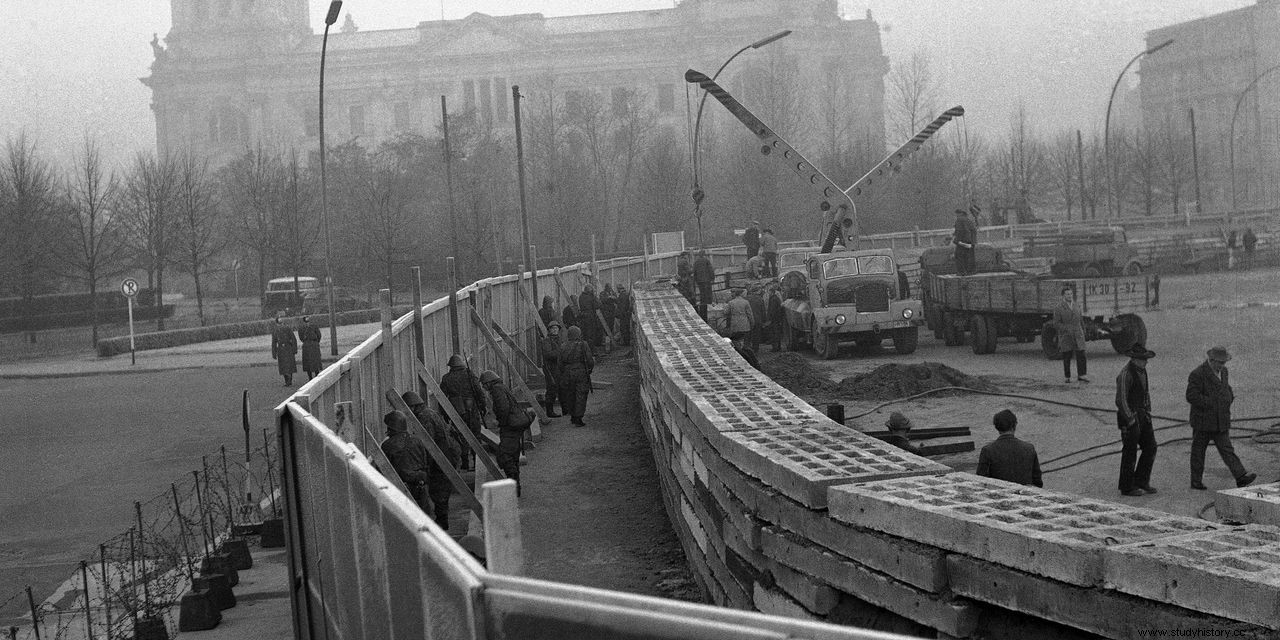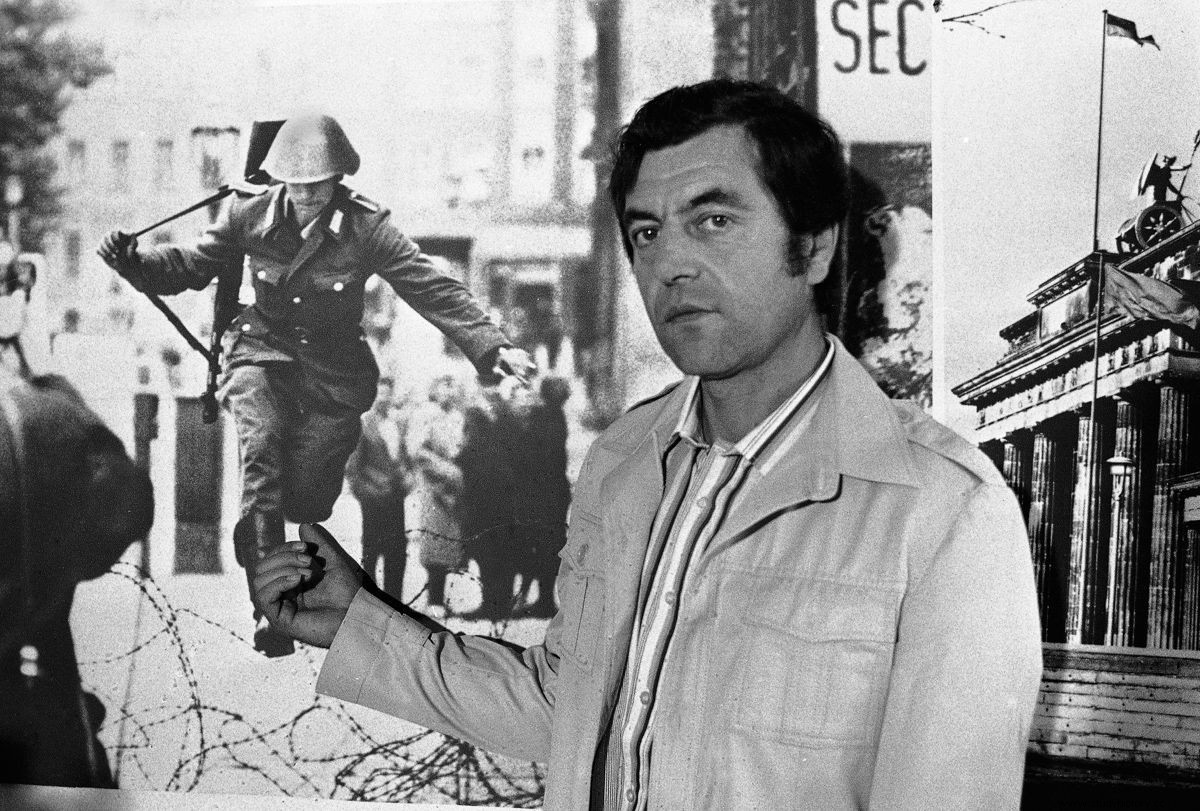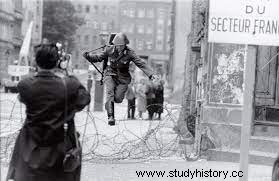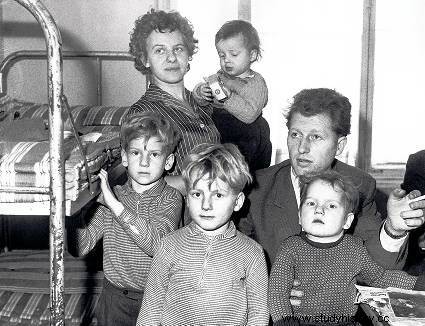
The Berlin Wall was a spike barrier for the influx of refugees to find freedom after World War 2. The Communist government of the German Democratic Republic (GDR) was concerned about the seemingly endless influx of refugees. Nearly 3 million young skilled workers, such as engineers, teachers, doctors and nurses, had found a way to leave the GDR since the end of the blockade. In June 1961 alone, about 19,000 30,000 people marched west through Berlin. In July, 16,000 2,400 East Germans crossed the border, and in August, XNUMX XNUMX fled. The culmination was that XNUMX defectors crossed the border in a single day.
Before the construction of the wall, the residents on both sides of Berlin moved freely enough. They crossed the border to visit, work, shop, enjoy play pieces or movies. Trains and subway lines ran back and forth. But all kinds of transport or communication were locked after the construction of the wall and the spike barrier, except for three checkpoints:Helmstedt, Dreilinden and the center of Berlin. Allied diplomats and officials could enter or leave if they met the strict requirements of the German East.
Berlin Walls (1961 - 1989)

On August 13, 1961, East Germany decided to construct barbed wire and concrete to stop mass jumps from east to west. The Berlin Wall served as an ugly symbol of ideological division by sneaking through the city. It was almost 270 miles long and built with a spike barrier, under the control of attack dogs, and with a threat of 55,000 1961 landmines. Although the barrier almost lasted between 1989 and XNUMX, it could not maintain a massive democratic movement. The enormous flight of defectors showed the not too distant fall of the Social Democratic Democratic Republic.
Narrow escapes from the Berlin Wall
Right after building the border between the Federal Republic of Germany and the GDR, the East Germans found the ruling government full of inhumanity and looked for a life in freedom. Despite many threats, dangers and deaths, the Berliners tried some means to realize their will or dream of seeking freedom at all costs. Some were lucky to have narrow refugees from the current government to go to a land of freedom, while others lost their lives in a communist country.
Conrad Schumann

Conrad Schumann was born in 1942 into a middle-class family living in agriculture. From childhood, his father trained him as a shepherd to help the family oversee a flock of 50 sheep. At the age of 19, he joined the army and was assigned to a border police officer. On the afternoon of August 15, 1961, as Chief Constable, he took a regular patrol right on the spike barrier at Bernauer Straße. When the government decided to close the border on 13 August 1961, his unit was stationed at the sector border.
The most famous border crossing

When the Berlin Wall began to be erected the day before, a low barbed barrier was set to mark the border. After a few days, Schumann took a patrol on the corner of Bernauer Strasse and Ruppiner Strasse and saw that it was an opportunity for him to carry out his dream of changing his life. At that moment he felt restless, walked nervously back and forth and smoked incessantly. Then he looked around to find out if a border guard was looking at him. He hesitated for a moment and decided to jump over the barbed wire barrier. Fortunately, a group of journalists wrote about what had happened on the other side of the Berlin Wall. Suddenly they saw a young man in army uniform jumping over the barbed wire barrier.
Jump into freedom
In fact, Conrad's border crossing was partly encouraged by the group of journalists on the side of West Germany. They paid attention to Constable Schumann Conrad for more than an hour, as his behavior was a bit strange. Then they shouted at him, "Come over," which gave him more courage. Immediately after landing on the territory of West Germany, he received help from the police in West Berlin. Interestingly, the photographer, Peter Leibing, was standing near the wall at that moment. He immediately took a window of opportunity to capture the action of Conrad's jumping over a barber barrier. This image was featured in many magazines as a symbol of the Cold War.
New life in West Berlin
Conrad Schumann remained in the refugee camp in Marienfelde until the end of September. The West German government then supported him in settling in a new house in Bavaria. He got a job working in the Audi factory. The image of him jumping over a barbed wire barrier made him famous not only in the city, but also all over the world. However, it haunted him for the rest of his life, along with a lasting fear of the Stasi. He said in a press interview that he would never regret fleeing the Berlin Wall. But for unknown reasons he committed suicide by hanging from a limb of a tree in the middle of the summer of 1998. He died at the age of 56 and was buried in the back of the house or small garden in Kipfenberg in southern Germany.
Harry Deterling
Many Berliners tried to escape from East Germany by rail, by individual escapes such as hiding in or on top of trains. But Harry Deterling, a train engine driver, made a completely different departure:a group escape. He found an opportunity to escape along a still existing railway line connecting the Albrechtshof station. When he saw that the line had not been dismantled and the switches were still in operation, he discussed with the coal miner, Hartmut Lichy, a plan to break out. Both asked their close friends and relatives if they would join the trip.
The last train that left the Berlin Wall

Deterling decided that December 5 was the starting day when he turned 28. He went with his wife and four children with Lichy's girlfriend; however, she missed the train full of risk. The day before, Deterling persuaded the boss to run an extra locomotive to develop his technical skills. People who were known were present before kl. 7 on the railway platform. 30 members of Deterling and his colleague received train tickets whose route would end at the Albrechshof. That night when Deterling drove locomotive 18 on a closed track, there were 234 people on board. Some unfortunate passengers did not understand what was happening. Finally, Deterling chuffed the last station in East Berlin in front of the border guard's complete surprise. The next day, the train line was destroyed immediately.
Deterlings congratulations on the day:freedom

Thanks to Deterling's daring, well-organized plan, five whole families arrived safely in the West. For Deterling, the escape from the barbed wire barrier in East Berlin was a true birthday present. At the refugee station, his wife celebrated her 28th birthday in the Marienfelde refugee camp with her companions. At the birthday party, Harry received a birthday kiss from his 24-year-old wife, Ingrid, who saw a bright future for her children on the path to education.
Wolfgang Engels

Wolfgang Engels was born into a communist family in 1943 in Düsseldorf, Germany. Growing up, his mother took him to East Germany after World War II. During his mother's teaching, he was willing to serve in the army of the German Democratic Republic or East Germany when he believed in the new ideology of the political system. He later realized that what he believed in the government was totally wrong, or he stayed on the wrong side. As a result, he hatched the idea of deflection from the Berlin Wall.
Breaks a concrete barrier with a tank

When he was a soldier who built the Berlin Wall, the pressure escaped the escape. When he came up with the idea of crossing the border with a tank, he became friends with some tank workers by letting them use their car for a spin. In return, they helped him drive a PSW 152 six-wheeler and instructed him on how the engines worked. When he mastered the operation of a tank, he was confident of waiting for the crews to have lunch in a shop at the end of a street. Thanks to a large amount of military traffic at that time, a car did not get more attention from other soldiers when he steered it east. Despite the vehicle's momentum, he was unable to break through the wall, which at the time was still a single-storey block with a height of almost three meters.
The Escape from the Berlin Wall
Unfortunately, Engels' tank did not make a full hole in the Berlin Wall and got stuck in his tank - and got stuck in the Berlin Wall. The East German soldiers poured out stories and began firing on his mind and himself. He shouted not to shoot, but they continued firing. He left the relative safety of the tank and climbed away. Unfortunately, he was shot once in the back and once in the hand. The other bullet went through his hand, in and then out. Eventually, the West German police fired from the other side back at the eastern border guards and covered Engels' escape.
In reality, a group of customers in a nearby bar saw him crossing the border and helping him pull him out of the barricade of West Germany's freedom. They made themselves like a human ladder to carry him over the wire. Then they took his unconscious body into a bar to wait for an ambulance.
Hot air balloon release

A colorful hot air balloon flight was performed by two young families, Strelzyks and Wetzels. It is a unique, unexpected idea that no East Berliner had ever thought of, which did not receive attention from East Germany at the moment. Wetzel worked as a driver for a furniture and building materials company. He received bad marks against him in the eyes of East Germany as his father had illegally gone to West Germany. Thus, Wetzel had no opportunity to join the Communist Party. In addition, the GDR refused Wetzel's request to pursue physics after completing high school.
After that, he had no choice but to study forestry, masonry and truck driving to earn a living when he entered the real world. His passion for physics encouraged him in part to travel to West Germany and gave him technical knowledge. To calm his desire for science, he played with machines for the pastime. In 1974, when they met Peter Strelzyk, they decided to work together as a self-employed electrical group.
The science behind the balloon
In 1978, Wetzel's sister-in-law gave him a magazine article about the International Balloon Festival in New Mexico. When he saw colorful pictures of hot air balloons, he came up with the idea of going to West Germany with a hot air balloon. With such an idea, he immediately discussed Strelzyk with the plan to produce a hot air balloon. The science of hot air balloons is that air inside a balloon is heated by a burner and the balloon will rise. It is attached to a basket at the bottom to contain passengers and the burner and floats in the wind direction.
They bought a propane gas fuel to power the balloon, and some 12-centimeter-diameter stovepipes to connect a gas cylinder, and add a hose, valve, and nozzles. Then some of them went to different stores to buy materials for a basket. The East German government noticed if they bought a large number of materials in the same place. On April 28, 1978, they went to the opening of a forest to test their product, but nothing happened.
Tried again
They knew the miscalculation because the substance was porous and let the air out. Air-safe chemicals made the balloon heavier. Then they decided to burn it down to erase all traces of air emissions. In the following experiment, Wetzel and Strelzyk had more experience and detailed calculation. They prepared an appropriate amount of gases as well as the size of a balloon, especially powerful enough to float 8 people. Until September 15, they started the journey when the forecast for the day seemed perfect. Again, the flight did not go smoothly.
When Wetzel and Frank cut the anchor ropes in opposite corners, their action happened at the same time, causing the balloon to tip into the flaming burner. As a result, the drug caught fire. They used a fire extinguisher to put out the flames. The balloon rose to the sky at an altitude of 2,000 meters and the wind reached 50 km per hour. The problem was that they did not have the means to control the balloon. And their fate was praised by the wind. Finally, the balloon landed in the woods when it was out of gas. They went south and discovered a power plant in West Germany.
